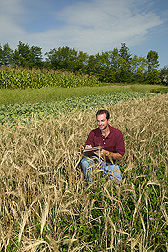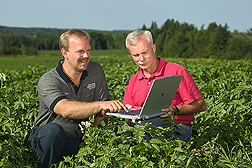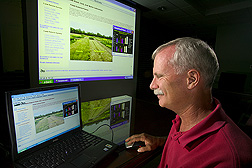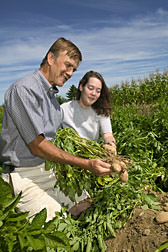Playing the Field
New resource helps potato farmers decide on the right crop rotations
With its slightly acidic soils and balmy summer days that give way to cool nights, Maine is an ideal place to raise America’s favorite veggie—the potato. These northern potatoes may make their way to your table through the fresh market, as ready-to-eat hash browns or wedges, or as parent seed for growing other potatoes. And rivaling the state’s other big breadwinner, lobsters, potatoes bring Maine about $300 million a year in sales.
But in the last few years, northern Maine’s conducive climate, generous riparian valleys, and even the state’s longtime cultural ties to the tuber haven’t been enough to buoy local growers.
Don Flannery, executive director of the Maine Potato Board in Presque Isle, acknowledges that potato growers all over the country have been facing tough times—especially given the popularity of the low-carbohydrate diet, which frowns on the starchy potato.
“The low-carb movement has had a huge impact on our industry,” says Flannery. “It seems to be waning, but it’s affected tuber growers nationwide.”
In the late 1990s, C. Wayne Honeycutt, research leader of ARS’s New England Plant, Soil, and Water Laboratory in Orono, Maine, decided to see what the lab’s soil, plant disease, and economics experts could do for growers. He convened a “Research Visioning Workshop” that many from across the state attended, including seed producers, table stock producers, processors, and county extension specialists.
“The top-priority research need identified at the workshop,” says Honeycutt, “was for information to develop profitable crop rotations.” Not only can the right rotation bring growers additional income, it can also be an effective way of suppressing potato diseases, enhancing soil nutrient content, and boosting crop productivity—all while reducing use of chemicals.
Crops That Complement
“Their needs weren’t a surprise to us,” says Honeycutt. “Growing potatoes year after year can lead to disease buildup and reduced soil fertility.”
|
|
So Honeycutt brainstormed a list of potential crops that could grow in sequence with potatoes. Typical pairings included barley and oats. Others were newer to the area, like canola and soybeans.
After 8 years of research with various rotations, the lab has produced decision-support software, called the “Potato Systems Planner,” that weaves together all the laboratory’s research findings on possible crop rotations for potatoes. The ARS scientists looked at the rotations from the standpoints of yield, level of nitrogen recycling, soil microorganism activity, disease incidence, and economic feasibility.
According to the lab’s plant pathologist Robert Larkin, potato diseases—which reduce yields and require costly chemical treatments—were a critical area to address.
“In Maine, there are persistent diseases that are a problem for almost every grower,” says Larkin. “One of these is Rhizoctonia, the fungus which causes stem canker and black scurf.” Affecting young potato plants as they grow, stem canker can cause lesions on roots and stems. More insidious is black scurf, which doesn’t show up until after tubers are harvested.
A Promising Star: Canola
But Larkin may have found a way to snuff out those diseases—by using sulfur. His form of sulfur actually comes from live plants in the Brassica genus—such as broccoli, cauliflower, turnip, radish, and canola.
|
|
“All Brassica plants produce sulfur compounds called glucosinolates. So about halfway through the potato-planner project, we started looking at rapeseed as well as canola,” he says. Rapeseed and canola are the same species of plant, but canola is bred specifically for its edible oil and has to meet specific standards. Both canola and rapeseed worked well against the problematic Rhizoctonia fungus.
“Rapeseed has higher levels of these antimicrobial compounds than canola, so it could have more impact on some diseases,” says Larkin. He’s still investigating the possibility, but he says that canola was the best of the six rotation crops studied for knocking down soil diseases.
Larkin explains that the Brassica crops act through biofumigation. “When sulfur compounds from canola or rapeseed break down in soil,” he says, “they produce volatile compounds called ‘isothiocyanates,’ which are toxic to many soil organisms. These compounds are very similar to those used in some commercial fumigants. They’re effective against many fungi and nematodes and even weed seeds.”
In other studies, Larkin is finding that another Brassica member, Oriental mustard, which contains even more glucosinolates than canola or rapeseed, can curb the fungus causing powdery scab. Scab is another persistent disease that can seriously affect tuber quality and marketability.
While he’s still researching the mustard’s specific potential and usage, Larkin foresees the glucosinolate-rich plant being used as a remedial crop—to sanitize problem fields and prepare them for tubers.
Brassica crops’ disease-suppressing capabilities are also being investigated at ARS’s Vegetable and Forage Crop Research Unit in Prosser, Washington—where potatoes also constitute a major crop.
Putting Stock in Potatoes
John Halloran, an ARS agricultural economist at the Maine lab, conducted economic analyses on the various rotations. Since potato yields in Maine have remained flat for the last few years, the financial component of the Potato Systems Planner should be a welcome tool for growers.
Halloran’s economics work was interwoven with Larkin’s pathogen work, since rotations that suppress disease should help growers cut costs.
“While I don’t have any hard figures,” says Halloran, “rotations that reduce potato diseases could bring significant savings because growers won’t have to use as many pesticides and herbicides, while attaining potentially higher yields and higher quality. Fewer chemical applications also mean lower costs.”
Halloran helped fit the software with an economic calculator that allows growers to plug in their own production costs, recent yield figures, and market prices to estimate the potential profitability of a particular cropping scenario.
“Most rotations, when compared to growing straight potatoes, reduced income variability,” says Halloran. “The idea is to diversify your crops—somewhat like diversifying your holdings in the stock market.”
Halloran hopes to establish an economic “risk preference” resource, which would help potato farmers—each with his or her own comfort level for risk—learn what rotation is best for them.
Growers interested in receiving copies of the Potato Systems Planner software may contact C. Wayne Honeycutt, phone (207) 581-3363.—By Erin K. Peabody, Agricultural Research Service Information Staff.
This research is part of Integrated Agricultural Systems, an ARS National Program (#207) described on the World Wide Web at www.nps.ars.usda.gov.
To reach scientists mentioned in this story, contact Erin Peabody, USDA-ARS Information Staff, 5601 Sunnyside Ave., Beltsville, MD 20705-5129; phone (301) 504-1624, fax (301) 504-1486.
"Playing the Field" was published in the December 2005 issue of Agricultural Research magazine.










